Leadership and Change Management: Styles, Development, and Culture
VerifiedAdded on 2021/01/01
|23
|6408
|417
Report
AI Summary
This report delves into leadership and change management, focusing on a case study of Solaris IT Solutions, a Malaysia-based IT company. It begins by examining the leadership grid model by Blake and Mouton, outlining various leadership styles such as Indifferent, Country Club, Status Quo, Dictatorial, Team, Opportunistic, and Paternalistic. The report then explores leadership development, defining it as the expansion of a person's capacity to perform leadership tasks. It identifies and summarizes various leadership development programs that Solaris IT Solutions can implement, including communication, conflict resolution, presentation skills, team building, business development strategy, operations leadership, and senior leadership courses. Finally, the report assesses the impact of cultural factors on leadership practices, considering the dimensions of national culture. The report concludes with a discussion of change management, addressing different types of changes, resistance to change, and theoretical perspectives on organizational change, providing a comprehensive overview of leadership and change management principles applicable to the business world.
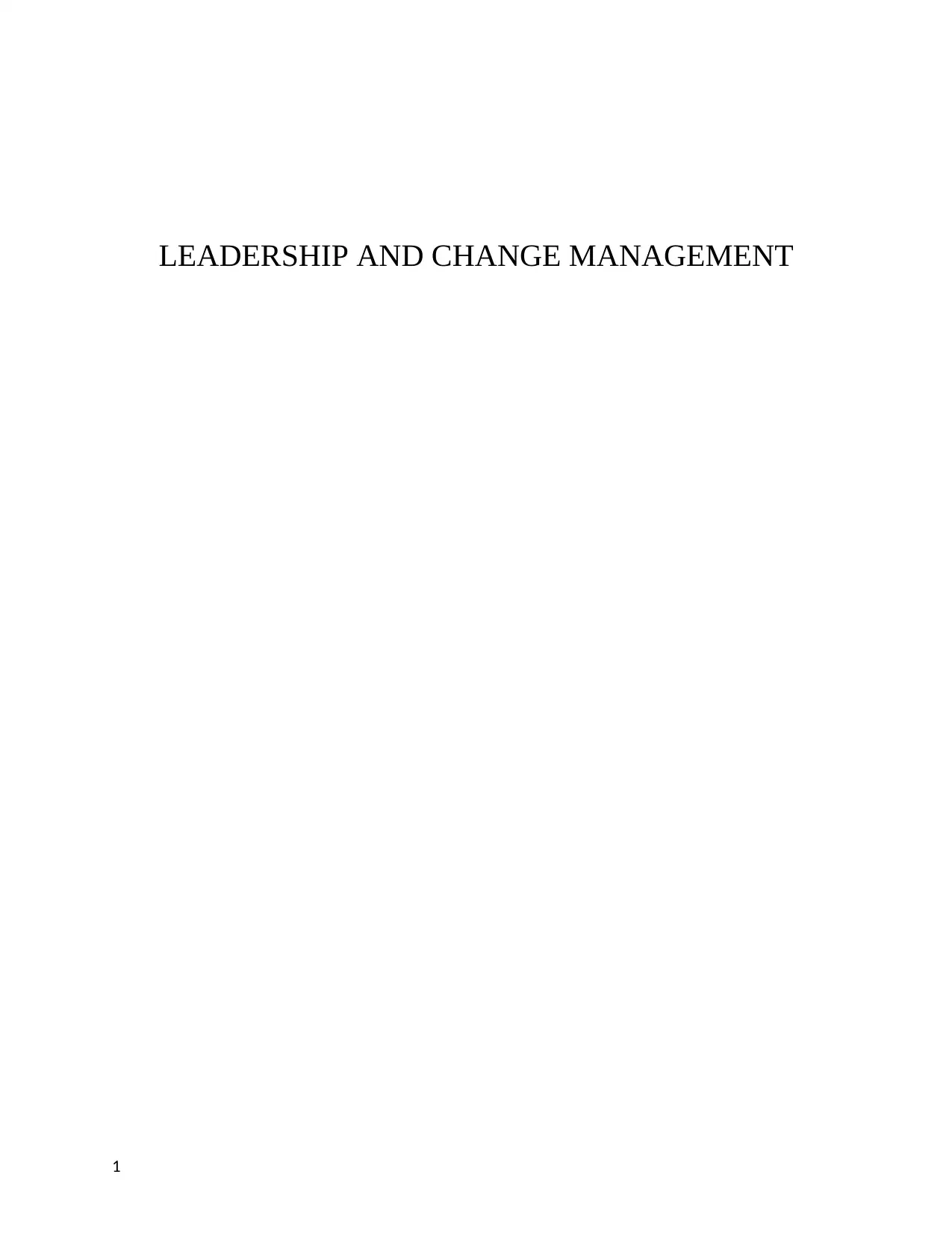
LEADERSHIP AND CHANGE MANAGEMENT
1
1
Paraphrase This Document
Need a fresh take? Get an instant paraphrase of this document with our AI Paraphraser
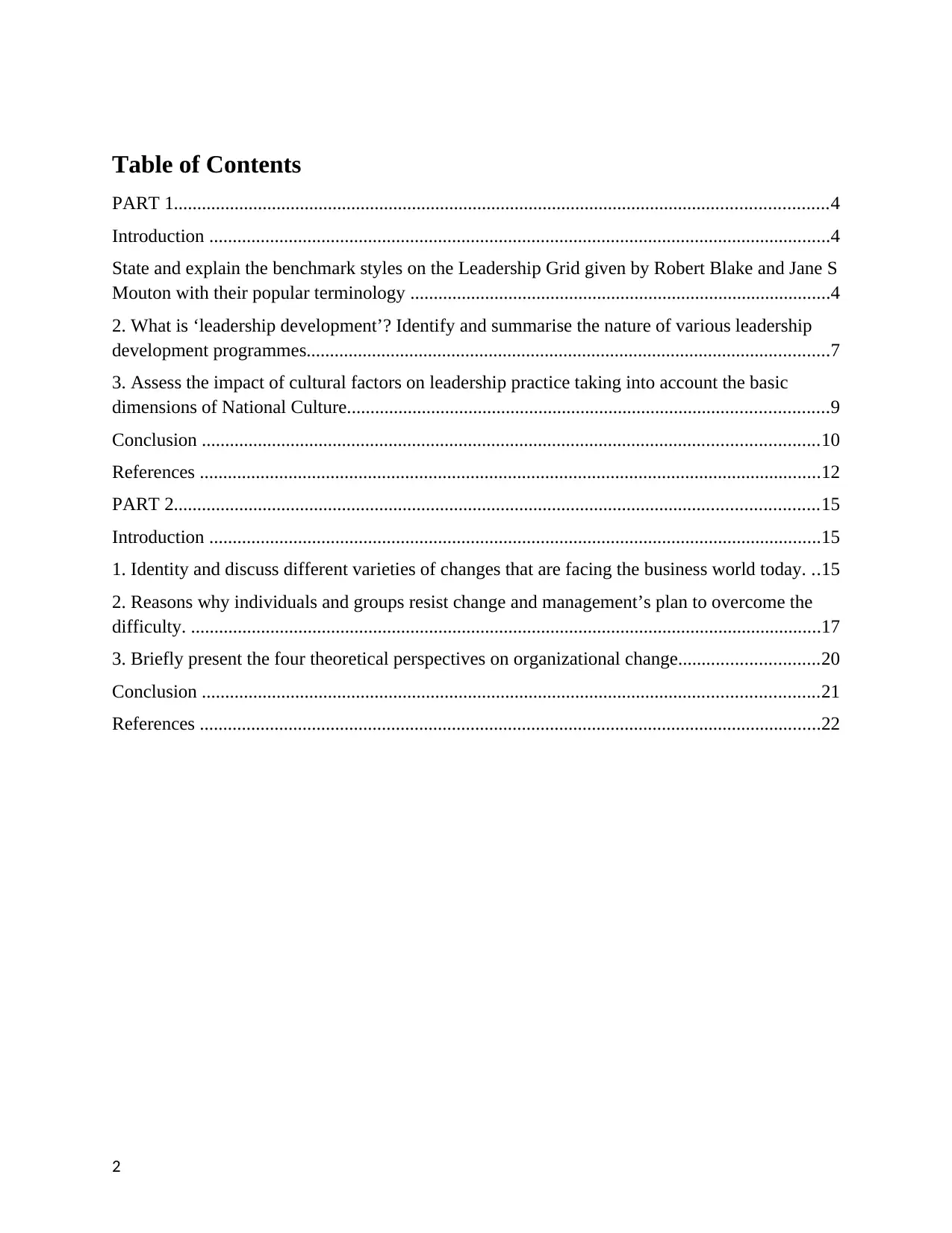
Table of Contents
PART 1............................................................................................................................................4
Introduction .....................................................................................................................................4
State and explain the benchmark styles on the Leadership Grid given by Robert Blake and Jane S
Mouton with their popular terminology ..........................................................................................4
2. What is ‘leadership development’? Identify and summarise the nature of various leadership
development programmes................................................................................................................7
3. Assess the impact of cultural factors on leadership practice taking into account the basic
dimensions of National Culture.......................................................................................................9
Conclusion ....................................................................................................................................10
References .....................................................................................................................................12
PART 2..........................................................................................................................................15
Introduction ...................................................................................................................................15
1. Identity and discuss different varieties of changes that are facing the business world today. ..15
2. Reasons why individuals and groups resist change and management’s plan to overcome the
difficulty. .......................................................................................................................................17
3. Briefly present the four theoretical perspectives on organizational change..............................20
Conclusion ....................................................................................................................................21
References .....................................................................................................................................22
2
PART 1............................................................................................................................................4
Introduction .....................................................................................................................................4
State and explain the benchmark styles on the Leadership Grid given by Robert Blake and Jane S
Mouton with their popular terminology ..........................................................................................4
2. What is ‘leadership development’? Identify and summarise the nature of various leadership
development programmes................................................................................................................7
3. Assess the impact of cultural factors on leadership practice taking into account the basic
dimensions of National Culture.......................................................................................................9
Conclusion ....................................................................................................................................10
References .....................................................................................................................................12
PART 2..........................................................................................................................................15
Introduction ...................................................................................................................................15
1. Identity and discuss different varieties of changes that are facing the business world today. ..15
2. Reasons why individuals and groups resist change and management’s plan to overcome the
difficulty. .......................................................................................................................................17
3. Briefly present the four theoretical perspectives on organizational change..............................20
Conclusion ....................................................................................................................................21
References .....................................................................................................................................22
2

3
⊘ This is a preview!⊘
Do you want full access?
Subscribe today to unlock all pages.

Trusted by 1+ million students worldwide
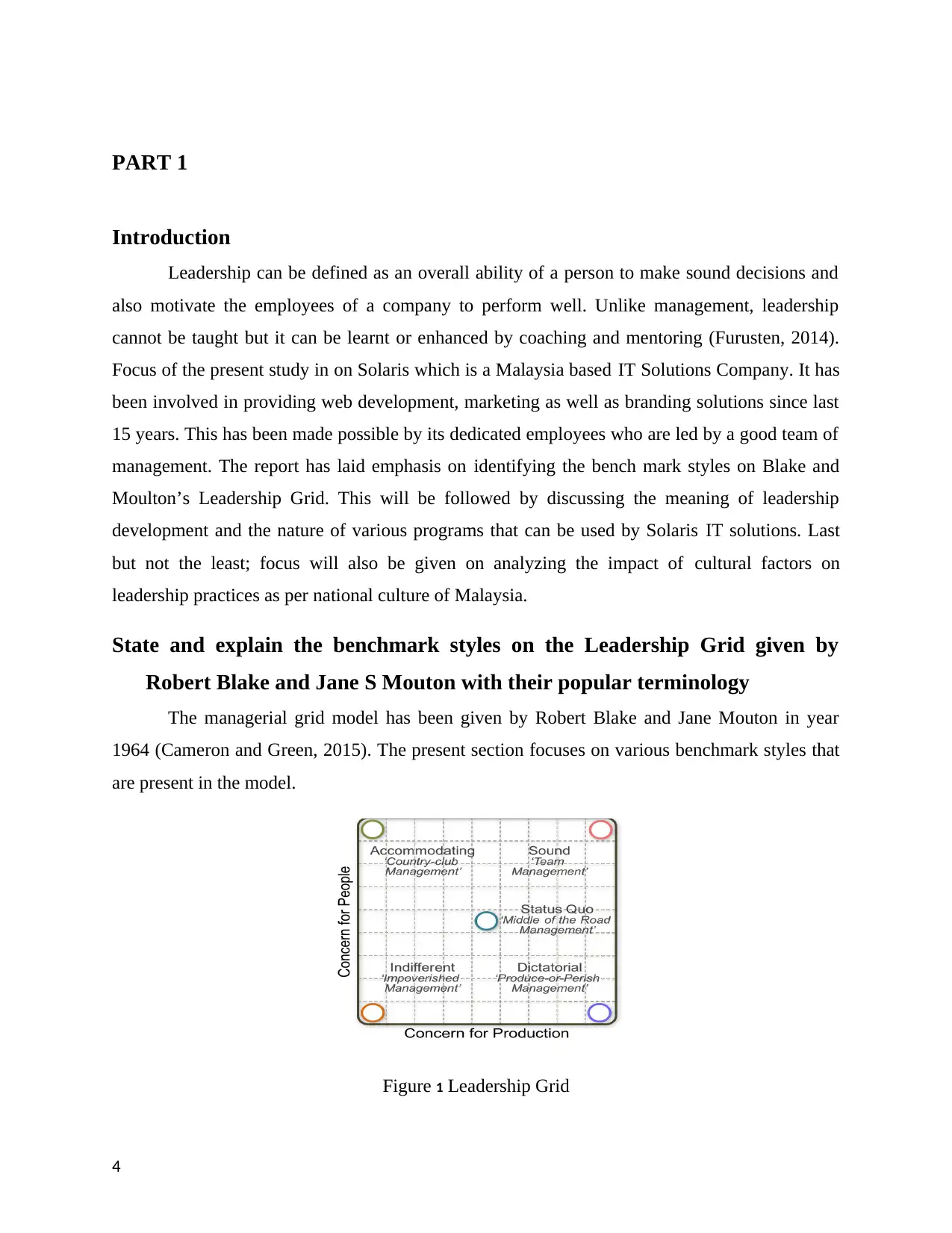
PART 1
Introduction
Leadership can be defined as an overall ability of a person to make sound decisions and
also motivate the employees of a company to perform well. Unlike management, leadership
cannot be taught but it can be learnt or enhanced by coaching and mentoring (Furusten, 2014).
Focus of the present study in on Solaris which is a Malaysia based IT Solutions Company. It has
been involved in providing web development, marketing as well as branding solutions since last
15 years. This has been made possible by its dedicated employees who are led by a good team of
management. The report has laid emphasis on identifying the bench mark styles on Blake and
Moulton’s Leadership Grid. This will be followed by discussing the meaning of leadership
development and the nature of various programs that can be used by Solaris IT solutions. Last
but not the least; focus will also be given on analyzing the impact of cultural factors on
leadership practices as per national culture of Malaysia.
State and explain the benchmark styles on the Leadership Grid given by
Robert Blake and Jane S Mouton with their popular terminology
The managerial grid model has been given by Robert Blake and Jane Mouton in year
1964 (Cameron and Green, 2015). The present section focuses on various benchmark styles that
are present in the model.
Figure 1 Leadership Grid
4
Introduction
Leadership can be defined as an overall ability of a person to make sound decisions and
also motivate the employees of a company to perform well. Unlike management, leadership
cannot be taught but it can be learnt or enhanced by coaching and mentoring (Furusten, 2014).
Focus of the present study in on Solaris which is a Malaysia based IT Solutions Company. It has
been involved in providing web development, marketing as well as branding solutions since last
15 years. This has been made possible by its dedicated employees who are led by a good team of
management. The report has laid emphasis on identifying the bench mark styles on Blake and
Moulton’s Leadership Grid. This will be followed by discussing the meaning of leadership
development and the nature of various programs that can be used by Solaris IT solutions. Last
but not the least; focus will also be given on analyzing the impact of cultural factors on
leadership practices as per national culture of Malaysia.
State and explain the benchmark styles on the Leadership Grid given by
Robert Blake and Jane S Mouton with their popular terminology
The managerial grid model has been given by Robert Blake and Jane Mouton in year
1964 (Cameron and Green, 2015). The present section focuses on various benchmark styles that
are present in the model.
Figure 1 Leadership Grid
4
Paraphrase This Document
Need a fresh take? Get an instant paraphrase of this document with our AI Paraphraser
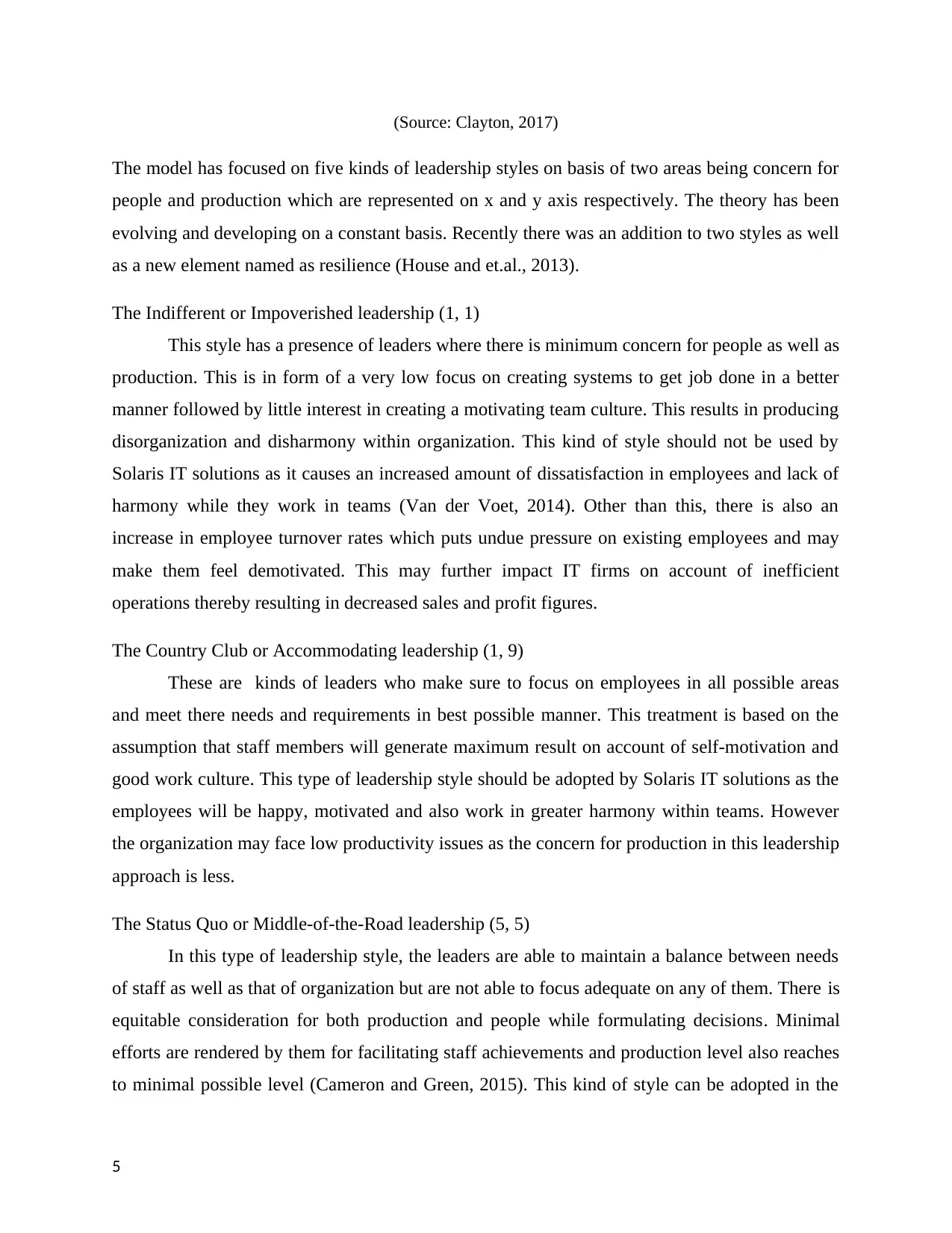
(Source: Clayton, 2017)
The model has focused on five kinds of leadership styles on basis of two areas being concern for
people and production which are represented on x and y axis respectively. The theory has been
evolving and developing on a constant basis. Recently there was an addition to two styles as well
as a new element named as resilience (House and et.al., 2013).
The Indifferent or Impoverished leadership (1, 1)
This style has a presence of leaders where there is minimum concern for people as well as
production. This is in form of a very low focus on creating systems to get job done in a better
manner followed by little interest in creating a motivating team culture. This results in producing
disorganization and disharmony within organization. This kind of style should not be used by
Solaris IT solutions as it causes an increased amount of dissatisfaction in employees and lack of
harmony while they work in teams (Van der Voet, 2014). Other than this, there is also an
increase in employee turnover rates which puts undue pressure on existing employees and may
make them feel demotivated. This may further impact IT firms on account of inefficient
operations thereby resulting in decreased sales and profit figures.
The Country Club or Accommodating leadership (1, 9)
These are kinds of leaders who make sure to focus on employees in all possible areas
and meet there needs and requirements in best possible manner. This treatment is based on the
assumption that staff members will generate maximum result on account of self-motivation and
good work culture. This type of leadership style should be adopted by Solaris IT solutions as the
employees will be happy, motivated and also work in greater harmony within teams. However
the organization may face low productivity issues as the concern for production in this leadership
approach is less.
The Status Quo or Middle-of-the-Road leadership (5, 5)
In this type of leadership style, the leaders are able to maintain a balance between needs
of staff as well as that of organization but are not able to focus adequate on any of them. There is
equitable consideration for both production and people while formulating decisions. Minimal
efforts are rendered by them for facilitating staff achievements and production level also reaches
to minimal possible level (Cameron and Green, 2015). This kind of style can be adopted in the
5
The model has focused on five kinds of leadership styles on basis of two areas being concern for
people and production which are represented on x and y axis respectively. The theory has been
evolving and developing on a constant basis. Recently there was an addition to two styles as well
as a new element named as resilience (House and et.al., 2013).
The Indifferent or Impoverished leadership (1, 1)
This style has a presence of leaders where there is minimum concern for people as well as
production. This is in form of a very low focus on creating systems to get job done in a better
manner followed by little interest in creating a motivating team culture. This results in producing
disorganization and disharmony within organization. This kind of style should not be used by
Solaris IT solutions as it causes an increased amount of dissatisfaction in employees and lack of
harmony while they work in teams (Van der Voet, 2014). Other than this, there is also an
increase in employee turnover rates which puts undue pressure on existing employees and may
make them feel demotivated. This may further impact IT firms on account of inefficient
operations thereby resulting in decreased sales and profit figures.
The Country Club or Accommodating leadership (1, 9)
These are kinds of leaders who make sure to focus on employees in all possible areas
and meet there needs and requirements in best possible manner. This treatment is based on the
assumption that staff members will generate maximum result on account of self-motivation and
good work culture. This type of leadership style should be adopted by Solaris IT solutions as the
employees will be happy, motivated and also work in greater harmony within teams. However
the organization may face low productivity issues as the concern for production in this leadership
approach is less.
The Status Quo or Middle-of-the-Road leadership (5, 5)
In this type of leadership style, the leaders are able to maintain a balance between needs
of staff as well as that of organization but are not able to focus adequate on any of them. There is
equitable consideration for both production and people while formulating decisions. Minimal
efforts are rendered by them for facilitating staff achievements and production level also reaches
to minimal possible level (Cameron and Green, 2015). This kind of style can be adopted in the
5
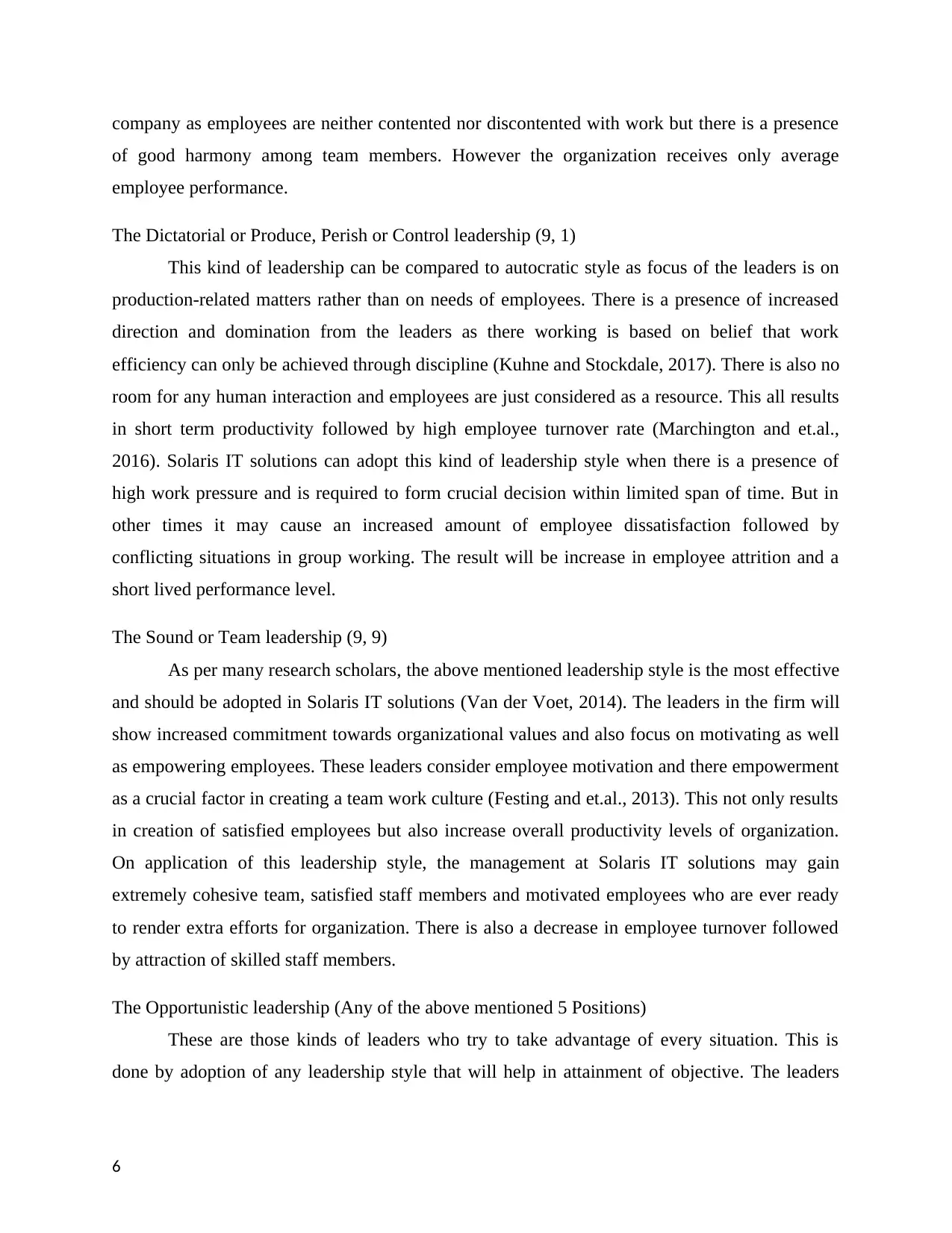
company as employees are neither contented nor discontented with work but there is a presence
of good harmony among team members. However the organization receives only average
employee performance.
The Dictatorial or Produce, Perish or Control leadership (9, 1)
This kind of leadership can be compared to autocratic style as focus of the leaders is on
production-related matters rather than on needs of employees. There is a presence of increased
direction and domination from the leaders as there working is based on belief that work
efficiency can only be achieved through discipline (Kuhne and Stockdale, 2017). There is also no
room for any human interaction and employees are just considered as a resource. This all results
in short term productivity followed by high employee turnover rate (Marchington and et.al.,
2016). Solaris IT solutions can adopt this kind of leadership style when there is a presence of
high work pressure and is required to form crucial decision within limited span of time. But in
other times it may cause an increased amount of employee dissatisfaction followed by
conflicting situations in group working. The result will be increase in employee attrition and a
short lived performance level.
The Sound or Team leadership (9, 9)
As per many research scholars, the above mentioned leadership style is the most effective
and should be adopted in Solaris IT solutions (Van der Voet, 2014). The leaders in the firm will
show increased commitment towards organizational values and also focus on motivating as well
as empowering employees. These leaders consider employee motivation and there empowerment
as a crucial factor in creating a team work culture (Festing and et.al., 2013). This not only results
in creation of satisfied employees but also increase overall productivity levels of organization.
On application of this leadership style, the management at Solaris IT solutions may gain
extremely cohesive team, satisfied staff members and motivated employees who are ever ready
to render extra efforts for organization. There is also a decrease in employee turnover followed
by attraction of skilled staff members.
The Opportunistic leadership (Any of the above mentioned 5 Positions)
These are those kinds of leaders who try to take advantage of every situation. This is
done by adoption of any leadership style that will help in attainment of objective. The leaders
6
of good harmony among team members. However the organization receives only average
employee performance.
The Dictatorial or Produce, Perish or Control leadership (9, 1)
This kind of leadership can be compared to autocratic style as focus of the leaders is on
production-related matters rather than on needs of employees. There is a presence of increased
direction and domination from the leaders as there working is based on belief that work
efficiency can only be achieved through discipline (Kuhne and Stockdale, 2017). There is also no
room for any human interaction and employees are just considered as a resource. This all results
in short term productivity followed by high employee turnover rate (Marchington and et.al.,
2016). Solaris IT solutions can adopt this kind of leadership style when there is a presence of
high work pressure and is required to form crucial decision within limited span of time. But in
other times it may cause an increased amount of employee dissatisfaction followed by
conflicting situations in group working. The result will be increase in employee attrition and a
short lived performance level.
The Sound or Team leadership (9, 9)
As per many research scholars, the above mentioned leadership style is the most effective
and should be adopted in Solaris IT solutions (Van der Voet, 2014). The leaders in the firm will
show increased commitment towards organizational values and also focus on motivating as well
as empowering employees. These leaders consider employee motivation and there empowerment
as a crucial factor in creating a team work culture (Festing and et.al., 2013). This not only results
in creation of satisfied employees but also increase overall productivity levels of organization.
On application of this leadership style, the management at Solaris IT solutions may gain
extremely cohesive team, satisfied staff members and motivated employees who are ever ready
to render extra efforts for organization. There is also a decrease in employee turnover followed
by attraction of skilled staff members.
The Opportunistic leadership (Any of the above mentioned 5 Positions)
These are those kinds of leaders who try to take advantage of every situation. This is
done by adoption of any leadership style that will help in attainment of objective. The leaders
6
⊘ This is a preview!⊘
Do you want full access?
Subscribe today to unlock all pages.

Trusted by 1+ million students worldwide
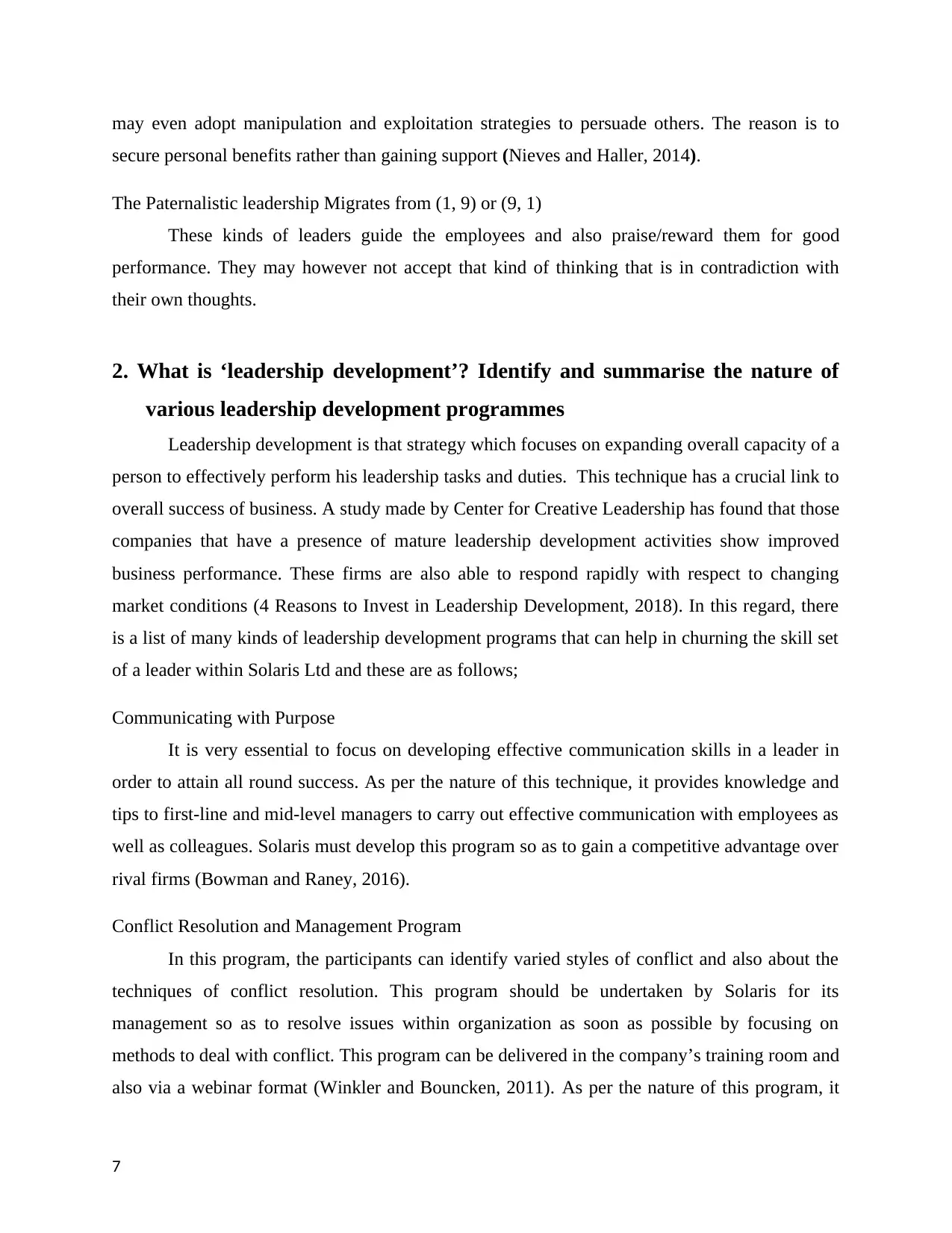
may even adopt manipulation and exploitation strategies to persuade others. The reason is to
secure personal benefits rather than gaining support (Nieves and Haller, 2014).
The Paternalistic leadership Migrates from (1, 9) or (9, 1)
These kinds of leaders guide the employees and also praise/reward them for good
performance. They may however not accept that kind of thinking that is in contradiction with
their own thoughts.
2. What is ‘leadership development’? Identify and summarise the nature of
various leadership development programmes
Leadership development is that strategy which focuses on expanding overall capacity of a
person to effectively perform his leadership tasks and duties. This technique has a crucial link to
overall success of business. A study made by Center for Creative Leadership has found that those
companies that have a presence of mature leadership development activities show improved
business performance. These firms are also able to respond rapidly with respect to changing
market conditions (4 Reasons to Invest in Leadership Development, 2018). In this regard, there
is a list of many kinds of leadership development programs that can help in churning the skill set
of a leader within Solaris Ltd and these are as follows;
Communicating with Purpose
It is very essential to focus on developing effective communication skills in a leader in
order to attain all round success. As per the nature of this technique, it provides knowledge and
tips to first-line and mid-level managers to carry out effective communication with employees as
well as colleagues. Solaris must develop this program so as to gain a competitive advantage over
rival firms (Bowman and Raney, 2016).
Conflict Resolution and Management Program
In this program, the participants can identify varied styles of conflict and also about the
techniques of conflict resolution. This program should be undertaken by Solaris for its
management so as to resolve issues within organization as soon as possible by focusing on
methods to deal with conflict. This program can be delivered in the company’s training room and
also via a webinar format (Winkler and Bouncken, 2011). As per the nature of this program, it
7
secure personal benefits rather than gaining support (Nieves and Haller, 2014).
The Paternalistic leadership Migrates from (1, 9) or (9, 1)
These kinds of leaders guide the employees and also praise/reward them for good
performance. They may however not accept that kind of thinking that is in contradiction with
their own thoughts.
2. What is ‘leadership development’? Identify and summarise the nature of
various leadership development programmes
Leadership development is that strategy which focuses on expanding overall capacity of a
person to effectively perform his leadership tasks and duties. This technique has a crucial link to
overall success of business. A study made by Center for Creative Leadership has found that those
companies that have a presence of mature leadership development activities show improved
business performance. These firms are also able to respond rapidly with respect to changing
market conditions (4 Reasons to Invest in Leadership Development, 2018). In this regard, there
is a list of many kinds of leadership development programs that can help in churning the skill set
of a leader within Solaris Ltd and these are as follows;
Communicating with Purpose
It is very essential to focus on developing effective communication skills in a leader in
order to attain all round success. As per the nature of this technique, it provides knowledge and
tips to first-line and mid-level managers to carry out effective communication with employees as
well as colleagues. Solaris must develop this program so as to gain a competitive advantage over
rival firms (Bowman and Raney, 2016).
Conflict Resolution and Management Program
In this program, the participants can identify varied styles of conflict and also about the
techniques of conflict resolution. This program should be undertaken by Solaris for its
management so as to resolve issues within organization as soon as possible by focusing on
methods to deal with conflict. This program can be delivered in the company’s training room and
also via a webinar format (Winkler and Bouncken, 2011). As per the nature of this program, it
7
Paraphrase This Document
Need a fresh take? Get an instant paraphrase of this document with our AI Paraphraser
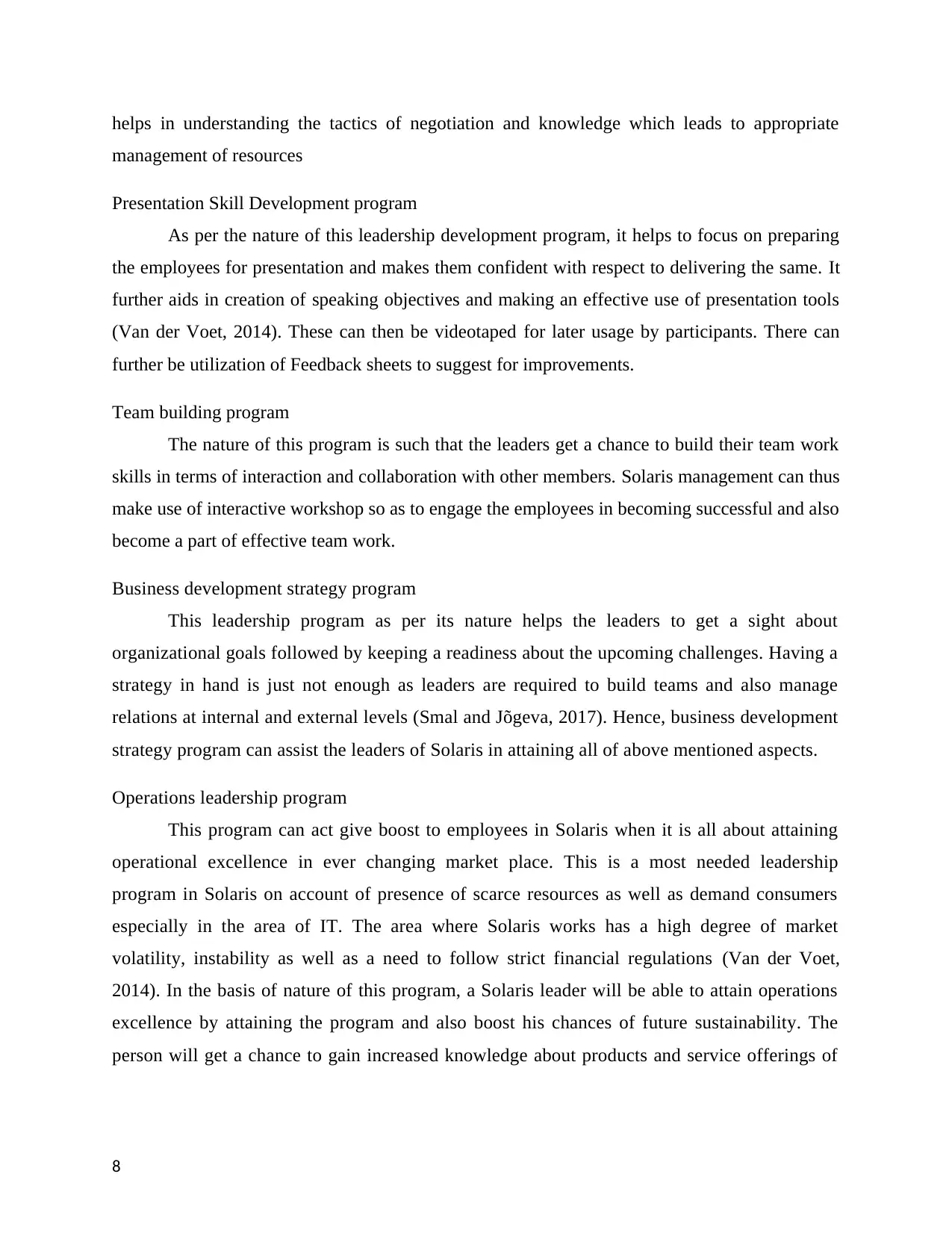
helps in understanding the tactics of negotiation and knowledge which leads to appropriate
management of resources
Presentation Skill Development program
As per the nature of this leadership development program, it helps to focus on preparing
the employees for presentation and makes them confident with respect to delivering the same. It
further aids in creation of speaking objectives and making an effective use of presentation tools
(Van der Voet, 2014). These can then be videotaped for later usage by participants. There can
further be utilization of Feedback sheets to suggest for improvements.
Team building program
The nature of this program is such that the leaders get a chance to build their team work
skills in terms of interaction and collaboration with other members. Solaris management can thus
make use of interactive workshop so as to engage the employees in becoming successful and also
become a part of effective team work.
Business development strategy program
This leadership program as per its nature helps the leaders to get a sight about
organizational goals followed by keeping a readiness about the upcoming challenges. Having a
strategy in hand is just not enough as leaders are required to build teams and also manage
relations at internal and external levels (Smal and Jõgeva, 2017). Hence, business development
strategy program can assist the leaders of Solaris in attaining all of above mentioned aspects.
Operations leadership program
This program can act give boost to employees in Solaris when it is all about attaining
operational excellence in ever changing market place. This is a most needed leadership
program in Solaris on account of presence of scarce resources as well as demand consumers
especially in the area of IT. The area where Solaris works has a high degree of market
volatility, instability as well as a need to follow strict financial regulations (Van der Voet,
2014). In the basis of nature of this program, a Solaris leader will be able to attain operations
excellence by attaining the program and also boost his chances of future sustainability. The
person will get a chance to gain increased knowledge about products and service offerings of
8
management of resources
Presentation Skill Development program
As per the nature of this leadership development program, it helps to focus on preparing
the employees for presentation and makes them confident with respect to delivering the same. It
further aids in creation of speaking objectives and making an effective use of presentation tools
(Van der Voet, 2014). These can then be videotaped for later usage by participants. There can
further be utilization of Feedback sheets to suggest for improvements.
Team building program
The nature of this program is such that the leaders get a chance to build their team work
skills in terms of interaction and collaboration with other members. Solaris management can thus
make use of interactive workshop so as to engage the employees in becoming successful and also
become a part of effective team work.
Business development strategy program
This leadership program as per its nature helps the leaders to get a sight about
organizational goals followed by keeping a readiness about the upcoming challenges. Having a
strategy in hand is just not enough as leaders are required to build teams and also manage
relations at internal and external levels (Smal and Jõgeva, 2017). Hence, business development
strategy program can assist the leaders of Solaris in attaining all of above mentioned aspects.
Operations leadership program
This program can act give boost to employees in Solaris when it is all about attaining
operational excellence in ever changing market place. This is a most needed leadership
program in Solaris on account of presence of scarce resources as well as demand consumers
especially in the area of IT. The area where Solaris works has a high degree of market
volatility, instability as well as a need to follow strict financial regulations (Van der Voet,
2014). In the basis of nature of this program, a Solaris leader will be able to attain operations
excellence by attaining the program and also boost his chances of future sustainability. The
person will get a chance to gain increased knowledge about products and service offerings of
8
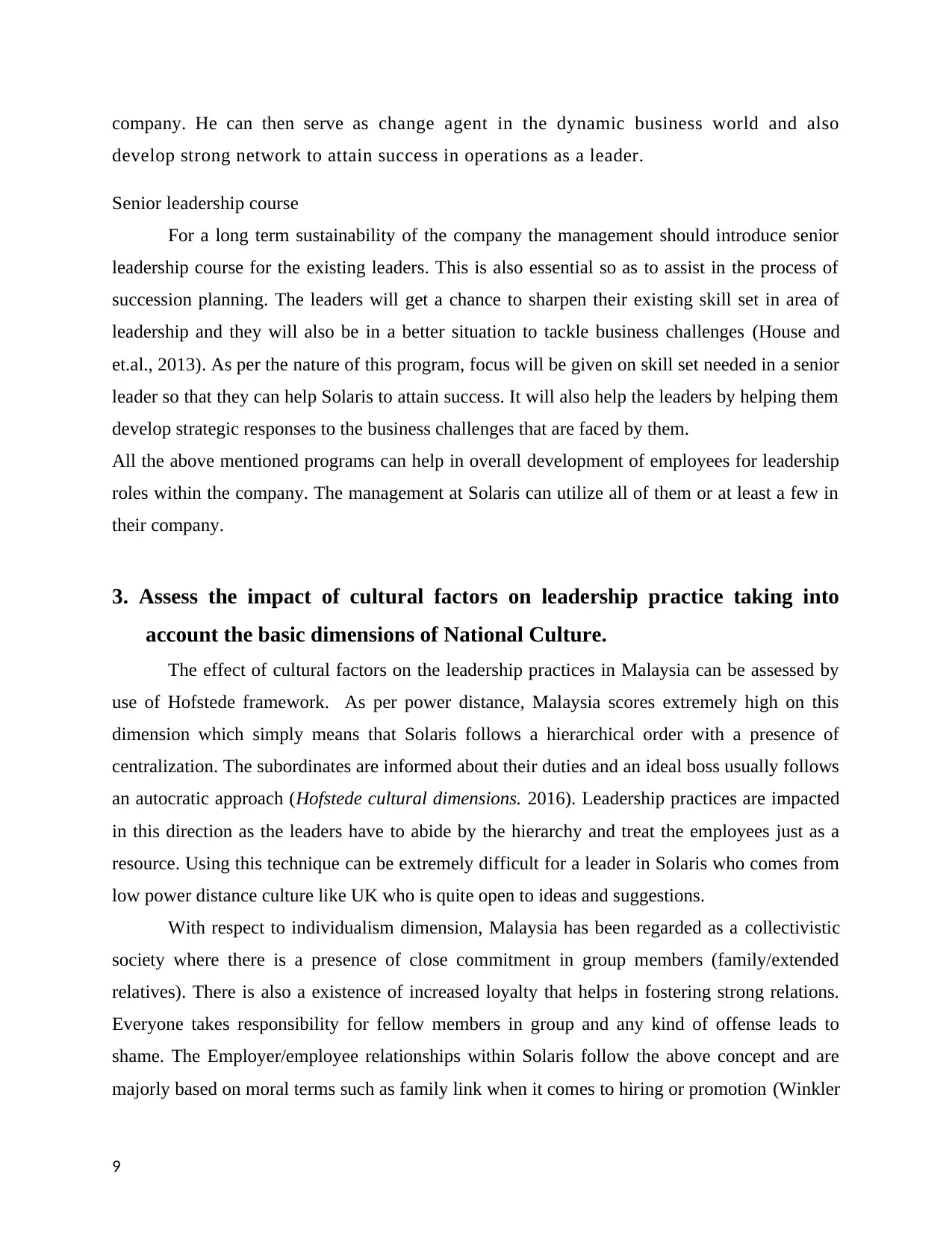
company. He can then serve as change agent in the dynamic business world and also
develop strong network to attain success in operations as a leader.
Senior leadership course
For a long term sustainability of the company the management should introduce senior
leadership course for the existing leaders. This is also essential so as to assist in the process of
succession planning. The leaders will get a chance to sharpen their existing skill set in area of
leadership and they will also be in a better situation to tackle business challenges (House and
et.al., 2013). As per the nature of this program, focus will be given on skill set needed in a senior
leader so that they can help Solaris to attain success. It will also help the leaders by helping them
develop strategic responses to the business challenges that are faced by them.
All the above mentioned programs can help in overall development of employees for leadership
roles within the company. The management at Solaris can utilize all of them or at least a few in
their company.
3. Assess the impact of cultural factors on leadership practice taking into
account the basic dimensions of National Culture.
The effect of cultural factors on the leadership practices in Malaysia can be assessed by
use of Hofstede framework. As per power distance, Malaysia scores extremely high on this
dimension which simply means that Solaris follows a hierarchical order with a presence of
centralization. The subordinates are informed about their duties and an ideal boss usually follows
an autocratic approach (Hofstede cultural dimensions. 2016). Leadership practices are impacted
in this direction as the leaders have to abide by the hierarchy and treat the employees just as a
resource. Using this technique can be extremely difficult for a leader in Solaris who comes from
low power distance culture like UK who is quite open to ideas and suggestions.
With respect to individualism dimension, Malaysia has been regarded as a collectivistic
society where there is a presence of close commitment in group members (family/extended
relatives). There is also a existence of increased loyalty that helps in fostering strong relations.
Everyone takes responsibility for fellow members in group and any kind of offense leads to
shame. The Employer/employee relationships within Solaris follow the above concept and are
majorly based on moral terms such as family link when it comes to hiring or promotion (Winkler
9
develop strong network to attain success in operations as a leader.
Senior leadership course
For a long term sustainability of the company the management should introduce senior
leadership course for the existing leaders. This is also essential so as to assist in the process of
succession planning. The leaders will get a chance to sharpen their existing skill set in area of
leadership and they will also be in a better situation to tackle business challenges (House and
et.al., 2013). As per the nature of this program, focus will be given on skill set needed in a senior
leader so that they can help Solaris to attain success. It will also help the leaders by helping them
develop strategic responses to the business challenges that are faced by them.
All the above mentioned programs can help in overall development of employees for leadership
roles within the company. The management at Solaris can utilize all of them or at least a few in
their company.
3. Assess the impact of cultural factors on leadership practice taking into
account the basic dimensions of National Culture.
The effect of cultural factors on the leadership practices in Malaysia can be assessed by
use of Hofstede framework. As per power distance, Malaysia scores extremely high on this
dimension which simply means that Solaris follows a hierarchical order with a presence of
centralization. The subordinates are informed about their duties and an ideal boss usually follows
an autocratic approach (Hofstede cultural dimensions. 2016). Leadership practices are impacted
in this direction as the leaders have to abide by the hierarchy and treat the employees just as a
resource. Using this technique can be extremely difficult for a leader in Solaris who comes from
low power distance culture like UK who is quite open to ideas and suggestions.
With respect to individualism dimension, Malaysia has been regarded as a collectivistic
society where there is a presence of close commitment in group members (family/extended
relatives). There is also a existence of increased loyalty that helps in fostering strong relations.
Everyone takes responsibility for fellow members in group and any kind of offense leads to
shame. The Employer/employee relationships within Solaris follow the above concept and are
majorly based on moral terms such as family link when it comes to hiring or promotion (Winkler
9
⊘ This is a preview!⊘
Do you want full access?
Subscribe today to unlock all pages.

Trusted by 1+ million students worldwide
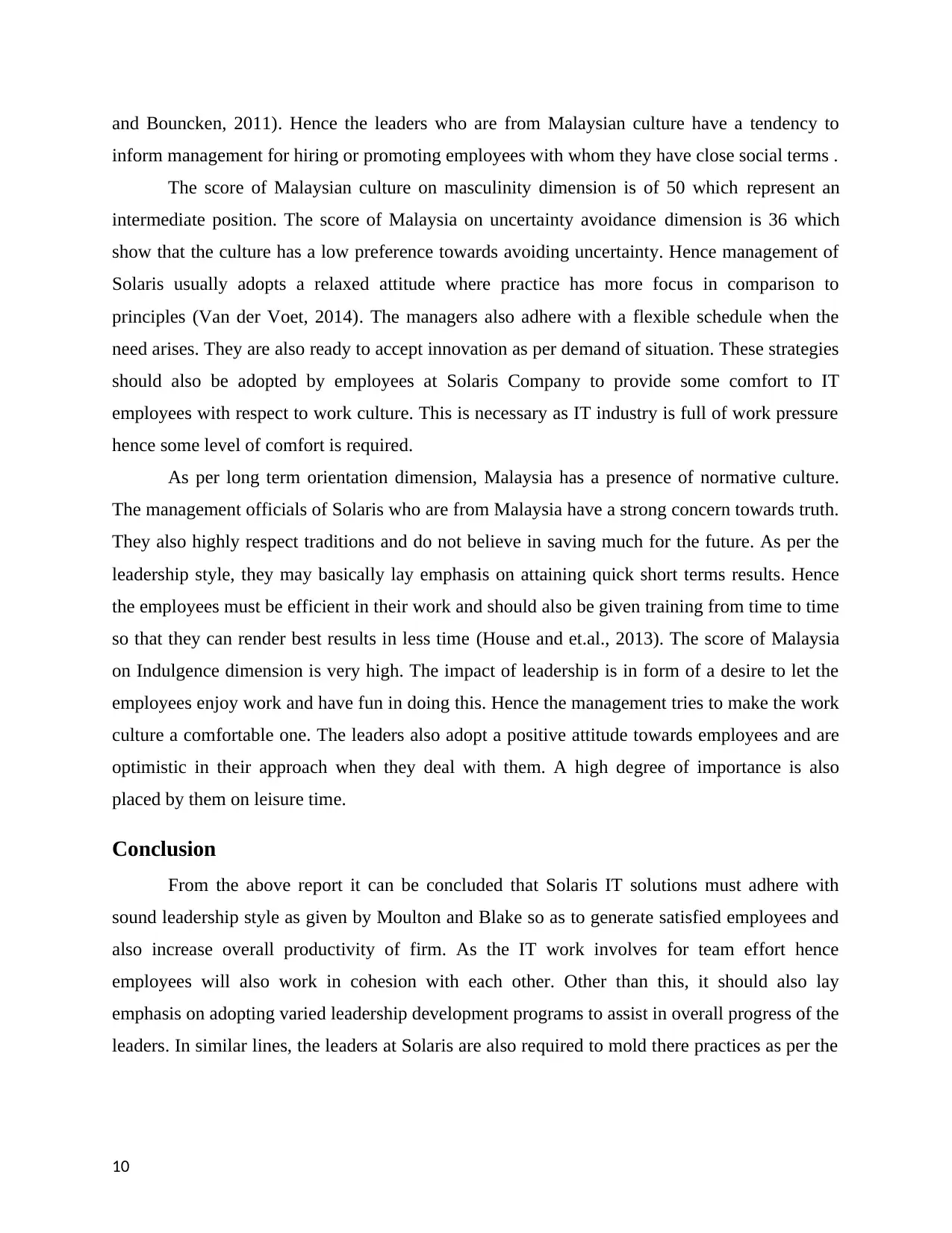
and Bouncken, 2011). Hence the leaders who are from Malaysian culture have a tendency to
inform management for hiring or promoting employees with whom they have close social terms .
The score of Malaysian culture on masculinity dimension is of 50 which represent an
intermediate position. The score of Malaysia on uncertainty avoidance dimension is 36 which
show that the culture has a low preference towards avoiding uncertainty. Hence management of
Solaris usually adopts a relaxed attitude where practice has more focus in comparison to
principles (Van der Voet, 2014). The managers also adhere with a flexible schedule when the
need arises. They are also ready to accept innovation as per demand of situation. These strategies
should also be adopted by employees at Solaris Company to provide some comfort to IT
employees with respect to work culture. This is necessary as IT industry is full of work pressure
hence some level of comfort is required.
As per long term orientation dimension, Malaysia has a presence of normative culture.
The management officials of Solaris who are from Malaysia have a strong concern towards truth.
They also highly respect traditions and do not believe in saving much for the future. As per the
leadership style, they may basically lay emphasis on attaining quick short terms results. Hence
the employees must be efficient in their work and should also be given training from time to time
so that they can render best results in less time (House and et.al., 2013). The score of Malaysia
on Indulgence dimension is very high. The impact of leadership is in form of a desire to let the
employees enjoy work and have fun in doing this. Hence the management tries to make the work
culture a comfortable one. The leaders also adopt a positive attitude towards employees and are
optimistic in their approach when they deal with them. A high degree of importance is also
placed by them on leisure time.
Conclusion
From the above report it can be concluded that Solaris IT solutions must adhere with
sound leadership style as given by Moulton and Blake so as to generate satisfied employees and
also increase overall productivity of firm. As the IT work involves for team effort hence
employees will also work in cohesion with each other. Other than this, it should also lay
emphasis on adopting varied leadership development programs to assist in overall progress of the
leaders. In similar lines, the leaders at Solaris are also required to mold there practices as per the
10
inform management for hiring or promoting employees with whom they have close social terms .
The score of Malaysian culture on masculinity dimension is of 50 which represent an
intermediate position. The score of Malaysia on uncertainty avoidance dimension is 36 which
show that the culture has a low preference towards avoiding uncertainty. Hence management of
Solaris usually adopts a relaxed attitude where practice has more focus in comparison to
principles (Van der Voet, 2014). The managers also adhere with a flexible schedule when the
need arises. They are also ready to accept innovation as per demand of situation. These strategies
should also be adopted by employees at Solaris Company to provide some comfort to IT
employees with respect to work culture. This is necessary as IT industry is full of work pressure
hence some level of comfort is required.
As per long term orientation dimension, Malaysia has a presence of normative culture.
The management officials of Solaris who are from Malaysia have a strong concern towards truth.
They also highly respect traditions and do not believe in saving much for the future. As per the
leadership style, they may basically lay emphasis on attaining quick short terms results. Hence
the employees must be efficient in their work and should also be given training from time to time
so that they can render best results in less time (House and et.al., 2013). The score of Malaysia
on Indulgence dimension is very high. The impact of leadership is in form of a desire to let the
employees enjoy work and have fun in doing this. Hence the management tries to make the work
culture a comfortable one. The leaders also adopt a positive attitude towards employees and are
optimistic in their approach when they deal with them. A high degree of importance is also
placed by them on leisure time.
Conclusion
From the above report it can be concluded that Solaris IT solutions must adhere with
sound leadership style as given by Moulton and Blake so as to generate satisfied employees and
also increase overall productivity of firm. As the IT work involves for team effort hence
employees will also work in cohesion with each other. Other than this, it should also lay
emphasis on adopting varied leadership development programs to assist in overall progress of the
leaders. In similar lines, the leaders at Solaris are also required to mold there practices as per the
10
Paraphrase This Document
Need a fresh take? Get an instant paraphrase of this document with our AI Paraphraser
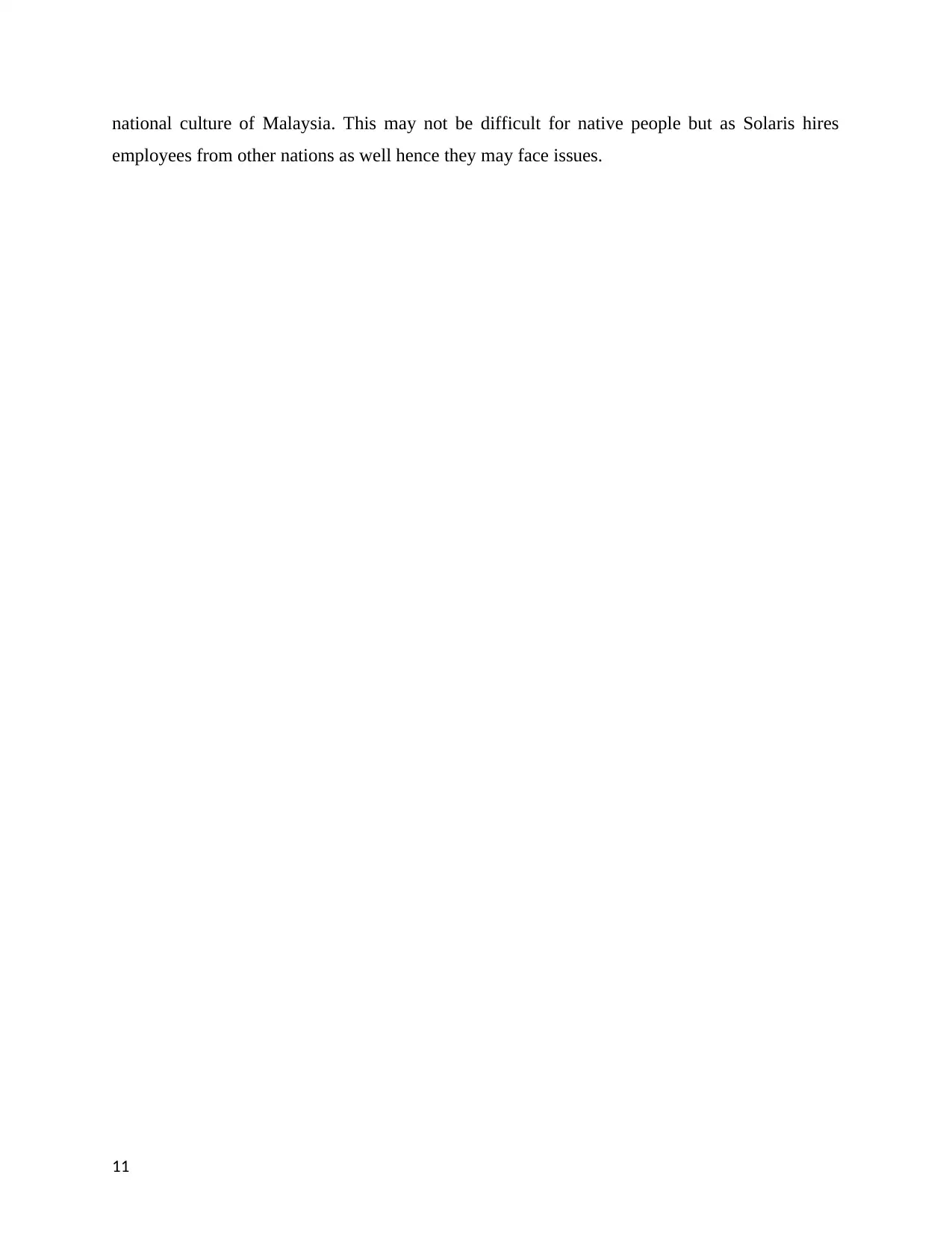
national culture of Malaysia. This may not be difficult for native people but as Solaris hires
employees from other nations as well hence they may face issues.
11
employees from other nations as well hence they may face issues.
11
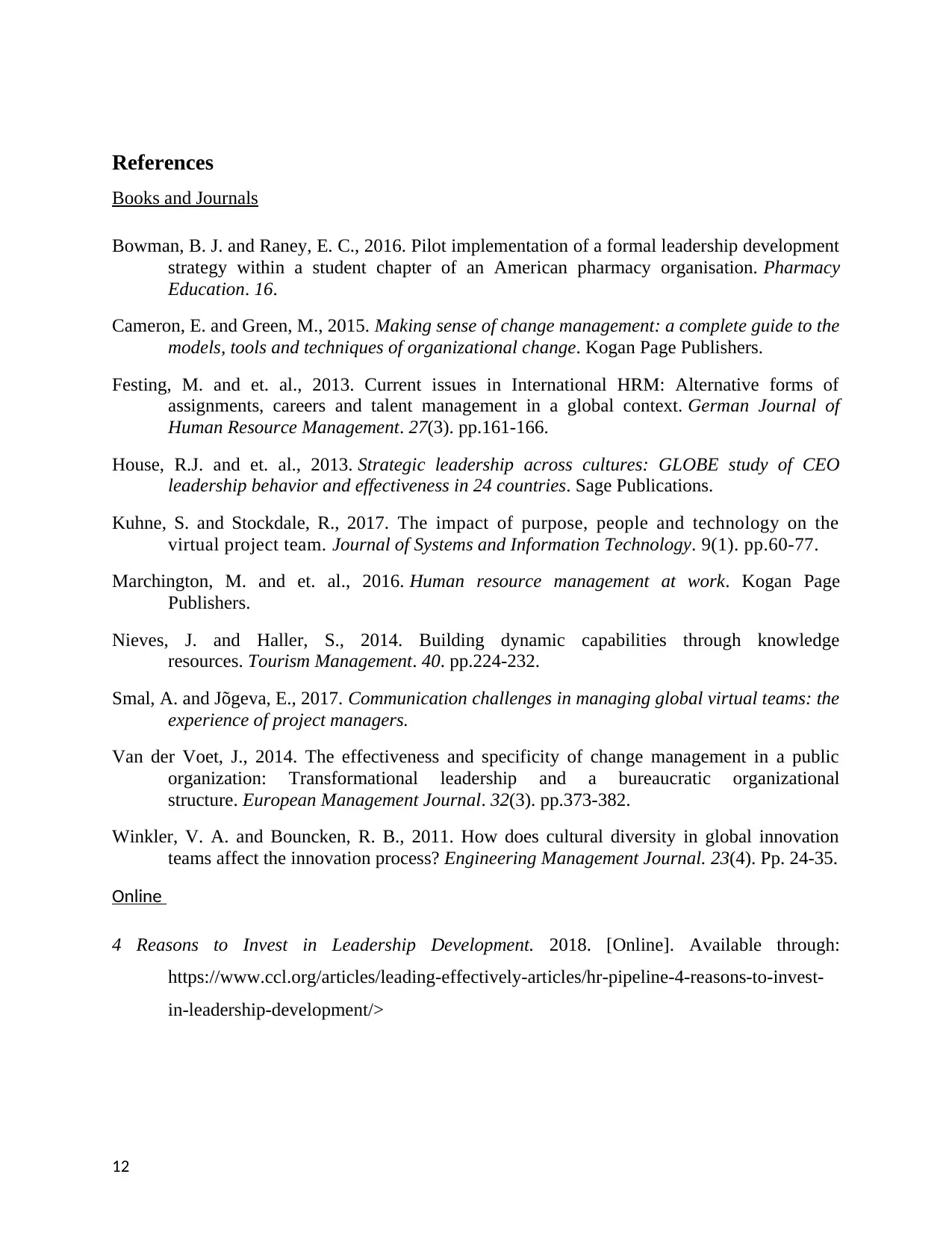
References
Books and Journals
Bowman, B. J. and Raney, E. C., 2016. Pilot implementation of a formal leadership development
strategy within a student chapter of an American pharmacy organisation. Pharmacy
Education. 16.
Cameron, E. and Green, M., 2015. Making sense of change management: a complete guide to the
models, tools and techniques of organizational change. Kogan Page Publishers.
Festing, M. and et. al., 2013. Current issues in International HRM: Alternative forms of
assignments, careers and talent management in a global context. German Journal of
Human Resource Management. 27(3). pp.161-166.
House, R.J. and et. al., 2013. Strategic leadership across cultures: GLOBE study of CEO
leadership behavior and effectiveness in 24 countries. Sage Publications.
Kuhne, S. and Stockdale, R., 2017. The impact of purpose, people and technology on the
virtual project team. Journal of Systems and Information Technology. 9(1). pp.60-77.
Marchington, M. and et. al., 2016. Human resource management at work. Kogan Page
Publishers.
Nieves, J. and Haller, S., 2014. Building dynamic capabilities through knowledge
resources. Tourism Management. 40. pp.224-232.
Smal, A. and Jõgeva, E., 2017. Communication challenges in managing global virtual teams: the
experience of project managers.
Van der Voet, J., 2014. The effectiveness and specificity of change management in a public
organization: Transformational leadership and a bureaucratic organizational
structure. European Management Journal. 32(3). pp.373-382.
Winkler, V. A. and Bouncken, R. B., 2011. How does cultural diversity in global innovation
teams affect the innovation process? Engineering Management Journal. 23(4). Pp. 24-35.
Online
4 Reasons to Invest in Leadership Development. 2018. [Online]. Available through:
https://www.ccl.org/articles/leading-effectively-articles/hr-pipeline-4-reasons-to-invest-
in-leadership-development/>
12
Books and Journals
Bowman, B. J. and Raney, E. C., 2016. Pilot implementation of a formal leadership development
strategy within a student chapter of an American pharmacy organisation. Pharmacy
Education. 16.
Cameron, E. and Green, M., 2015. Making sense of change management: a complete guide to the
models, tools and techniques of organizational change. Kogan Page Publishers.
Festing, M. and et. al., 2013. Current issues in International HRM: Alternative forms of
assignments, careers and talent management in a global context. German Journal of
Human Resource Management. 27(3). pp.161-166.
House, R.J. and et. al., 2013. Strategic leadership across cultures: GLOBE study of CEO
leadership behavior and effectiveness in 24 countries. Sage Publications.
Kuhne, S. and Stockdale, R., 2017. The impact of purpose, people and technology on the
virtual project team. Journal of Systems and Information Technology. 9(1). pp.60-77.
Marchington, M. and et. al., 2016. Human resource management at work. Kogan Page
Publishers.
Nieves, J. and Haller, S., 2014. Building dynamic capabilities through knowledge
resources. Tourism Management. 40. pp.224-232.
Smal, A. and Jõgeva, E., 2017. Communication challenges in managing global virtual teams: the
experience of project managers.
Van der Voet, J., 2014. The effectiveness and specificity of change management in a public
organization: Transformational leadership and a bureaucratic organizational
structure. European Management Journal. 32(3). pp.373-382.
Winkler, V. A. and Bouncken, R. B., 2011. How does cultural diversity in global innovation
teams affect the innovation process? Engineering Management Journal. 23(4). Pp. 24-35.
Online
4 Reasons to Invest in Leadership Development. 2018. [Online]. Available through:
https://www.ccl.org/articles/leading-effectively-articles/hr-pipeline-4-reasons-to-invest-
in-leadership-development/>
12
⊘ This is a preview!⊘
Do you want full access?
Subscribe today to unlock all pages.

Trusted by 1+ million students worldwide
1 out of 23
Related Documents
Your All-in-One AI-Powered Toolkit for Academic Success.
+13062052269
info@desklib.com
Available 24*7 on WhatsApp / Email
![[object Object]](/_next/static/media/star-bottom.7253800d.svg)
Unlock your academic potential
Copyright © 2020–2025 A2Z Services. All Rights Reserved. Developed and managed by ZUCOL.



![21st Century Management Portfolio: S22, [University Name]](/_next/image/?url=https%3A%2F%2Fdesklib.com%2Fmedia%2Fimages%2Fij%2Fff3146e3c84e475083bf9e98f125d231.jpg&w=256&q=75)

